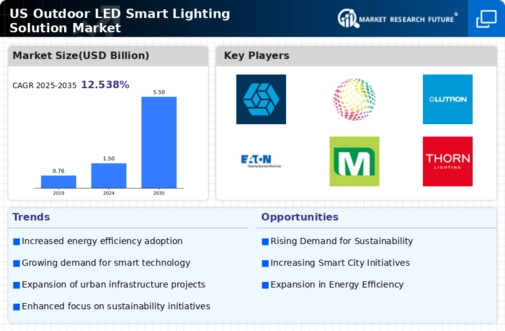Advancements in IoT Connectivity
The outdoor led-smart-lighting-solution market is significantly influenced by advancements in Internet of Things (IoT) connectivity. The proliferation of smart devices and sensors enables enhanced control and monitoring of outdoor lighting systems. This connectivity allows for real-time data collection and analysis, leading to improved operational efficiency and reduced maintenance costs. For instance, smart lighting systems can adjust brightness based on ambient light conditions, which not only enhances user experience but also contributes to energy savings. As IoT technology continues to evolve, its integration into outdoor lighting solutions is expected to propel the market forward, offering innovative functionalities that meet the needs of modern urban environments.
Government Initiatives and Incentives
Government initiatives and incentives play a crucial role in shaping the outdoor led-smart-lighting-solution market. Various federal and state programs are designed to promote energy-efficient technologies, including LED lighting. These initiatives often include financial incentives such as rebates and tax credits for municipalities and businesses that adopt smart lighting solutions. For example, the U.S. Department of Energy has implemented programs aimed at reducing energy consumption in public spaces. Such support not only encourages the adoption of outdoor led-smart-lighting solutions but also fosters a competitive market environment, driving innovation and reducing costs for end-users.
Growing Demand for Sustainable Solutions
The outdoor led-smart-lighting-solution market is experiencing a notable surge in demand for sustainable lighting solutions. As environmental concerns become increasingly prominent, municipalities and businesses are seeking energy-efficient alternatives to traditional lighting. The integration of LED technology not only reduces energy consumption but also minimizes carbon footprints. According to recent data, LED lighting can consume up to 75% less energy than incandescent bulbs, which aligns with the sustainability goals of many organizations. This shift towards eco-friendly solutions is likely to drive growth in the outdoor led-smart-lighting-solution market, as stakeholders prioritize investments in technologies that support environmental stewardship.
Rising Awareness of Smart Lighting Benefits
There is a growing awareness among consumers and businesses regarding the benefits of smart lighting solutions, which is positively impacting the outdoor led-smart-lighting-solution market. As more stakeholders recognize the advantages of LED technology, such as lower energy costs, longer lifespans, and enhanced control features, the demand for these solutions is expected to rise. Educational campaigns and industry advocacy are helping to disseminate information about the operational and financial benefits of smart lighting. This increased awareness is likely to drive adoption rates, as organizations seek to leverage the advantages of outdoor led-smart-lighting solutions to improve their operational efficiency and sustainability.
Urbanization and Infrastructure Development
The ongoing trend of urbanization is a significant driver of the outdoor led-smart-lighting-solution market. As cities expand and populations grow, there is an increasing need for efficient and effective lighting solutions in public spaces. Urban planners are increasingly incorporating smart lighting systems into infrastructure projects to enhance safety, visibility, and energy efficiency. The outdoor led-smart-lighting-solution market is likely to benefit from this trend, as municipalities invest in modernizing their lighting infrastructure. Furthermore, the integration of smart technologies in urban planning can lead to improved public safety and reduced crime rates, making these solutions more appealing to city officials.
























Leave a Comment